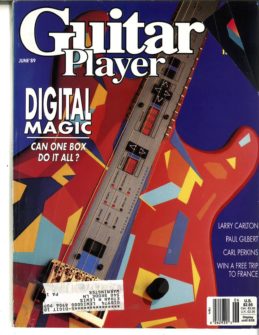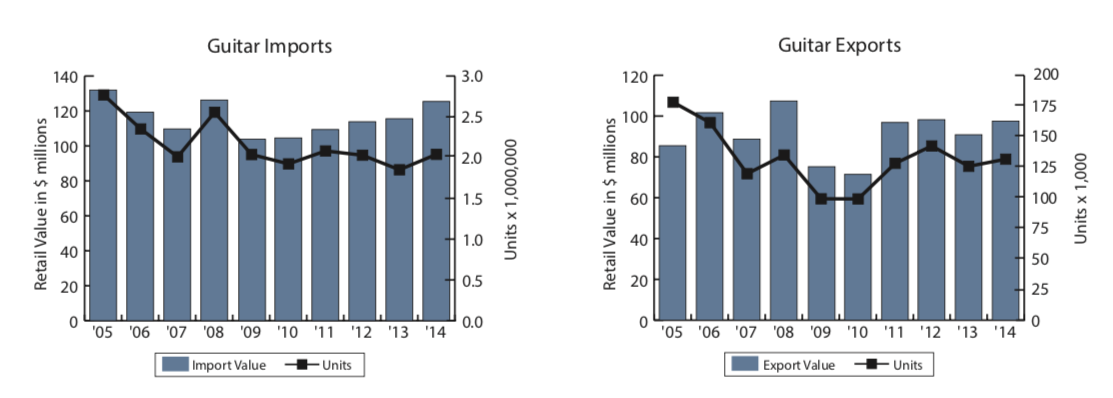Every month I re-read the Guitar Player magazine from exactly 30 years ago for my blog. Looking at the June, 1989 issue I was struck by the editorial which seemed to bemoan the trade imbalance on guitars.
******************

The opening editorial from publisher Jim Crockett was titled “The Balance of Payments”, and it discussed the 1988 statistics on imports and exports of acoustic and electric guitars. According to Crockett:
“…in 1988, about 611,400 acoustic guitars worth less than $100 each were imported into the U.S….And where did most of these come from? Not Japan, as some of you might assume, but from Korea, Taiwan and (ready?) China. In the area of over-$100 acoustics, the United States brought in a little over 41,000 instruments last year, most of those from just Korea and Taiwan.
How about electrics? In ’88, about 485,200 units were shipped into the U.S. Again, mostly Asian in origin. Altogether, America imported about 1,137,700 acoustic and electric guitars–up 167,500 from 1987.
In 1988, while Americans were importing 652,000 acoustic guitars, we were exporting just 29,600. Talk about your ‘imbalance’. And at the same time we were welcoming 485,200 foreign electric guitars, we sent out only 33,500.
Overall, America brought in 1,137,700 or so guitars, but exported merely 63,100. “
Well, there is a lot to unpack here, even beyond the fact that this simplistic analysis sounds like the kind of thing that around this same time led a somewhat well-known real estate mogul in New York to decide that “America was losing”. First of all, it sounds about right to me that guitar sales were increasing at this time, which was the peak of rock on MTV, with guitar solos on every pop song and grunge just a disquieting rumble in the distance. Second, I wish that Crockett had been able to give us dollar values of the imports and exports. Finally, I wonder what the numbers are like now, when so many people are proclaiming the end of the guitar (despite a seemingly endless supply of cheap guitars on Amazon and eBay).
Fortunately, I didn’t have too far to look. The 2015 NAMM Global Report is available online, and it is full of fascinating details, including these charts:

In other words, in 2014 (26 years after Crockett’s data), the United States imported 2 million guitars and exported just over 125,000. Both of these numbers are increases over the 1988 totals, but, interestingly are down quite a bit from 2005 before the Great Recession (and before the spread of smartphones). Now of course the U.S. population in 1990 was just under 249 million and by 2010 was over 310 million, so one could assume that the population increase alone should result in more guitarists, but I can’t do that kind of math. The report does say that:
“Acoustic guitars were the top performers in 2014. A 10% increase to 1,498,700 units translated into a 12.5% gain in retail value as customers opted for higher priced instruments. It’s difficult to pinpoint a single catalyst for the improvement. Retailers and manufacturers interviewed cited a better economic climate; the rise of singer-songwriters like Taylor Swift, who have attracted more female buyers, and consumers looking for an antidote to an increasingly digitized world.
In the realm of electric guitars, unit volume edged up 2% to 1,132,250, while estimated retail value increased 8.3% to $505.9 million. The shift to higher-priced products was generally welcomed by manufacturers and retailers….[h]owever, some still expressed concerns. ‘We’re seeing fewer first-time buyers and a lot more older guys adding instruments to their collection.'”
Interesting stuff, at least to me. And I can’t help but wonder where all these guitars are going. I mean, they aren’t disposable. A glance at Reverb as I write this on June 20th shows 131,550 used guitars available on the site, including 6,128 from the 1980’s–some of which might be the ones Crockett was talking about. So in some ways, this is probably a great time to be a guitar player due to the saturated market; I mean, you don’t have to look far or pay much for a guitar these days which makes it great for beginners and “collectors” alike. What do you think about this?
******************

The opening editorial from publisher Jim Crockett was titled “The Balance of Payments”, and it discussed the 1988 statistics on imports and exports of acoustic and electric guitars. According to Crockett:
“…in 1988, about 611,400 acoustic guitars worth less than $100 each were imported into the U.S….And where did most of these come from? Not Japan, as some of you might assume, but from Korea, Taiwan and (ready?) China. In the area of over-$100 acoustics, the United States brought in a little over 41,000 instruments last year, most of those from just Korea and Taiwan.
How about electrics? In ’88, about 485,200 units were shipped into the U.S. Again, mostly Asian in origin. Altogether, America imported about 1,137,700 acoustic and electric guitars–up 167,500 from 1987.
In 1988, while Americans were importing 652,000 acoustic guitars, we were exporting just 29,600. Talk about your ‘imbalance’. And at the same time we were welcoming 485,200 foreign electric guitars, we sent out only 33,500.
Overall, America brought in 1,137,700 or so guitars, but exported merely 63,100. “
Well, there is a lot to unpack here, even beyond the fact that this simplistic analysis sounds like the kind of thing that around this same time led a somewhat well-known real estate mogul in New York to decide that “America was losing”. First of all, it sounds about right to me that guitar sales were increasing at this time, which was the peak of rock on MTV, with guitar solos on every pop song and grunge just a disquieting rumble in the distance. Second, I wish that Crockett had been able to give us dollar values of the imports and exports. Finally, I wonder what the numbers are like now, when so many people are proclaiming the end of the guitar (despite a seemingly endless supply of cheap guitars on Amazon and eBay).
Fortunately, I didn’t have too far to look. The 2015 NAMM Global Report is available online, and it is full of fascinating details, including these charts:

In other words, in 2014 (26 years after Crockett’s data), the United States imported 2 million guitars and exported just over 125,000. Both of these numbers are increases over the 1988 totals, but, interestingly are down quite a bit from 2005 before the Great Recession (and before the spread of smartphones). Now of course the U.S. population in 1990 was just under 249 million and by 2010 was over 310 million, so one could assume that the population increase alone should result in more guitarists, but I can’t do that kind of math. The report does say that:
“Acoustic guitars were the top performers in 2014. A 10% increase to 1,498,700 units translated into a 12.5% gain in retail value as customers opted for higher priced instruments. It’s difficult to pinpoint a single catalyst for the improvement. Retailers and manufacturers interviewed cited a better economic climate; the rise of singer-songwriters like Taylor Swift, who have attracted more female buyers, and consumers looking for an antidote to an increasingly digitized world.
In the realm of electric guitars, unit volume edged up 2% to 1,132,250, while estimated retail value increased 8.3% to $505.9 million. The shift to higher-priced products was generally welcomed by manufacturers and retailers….[h]owever, some still expressed concerns. ‘We’re seeing fewer first-time buyers and a lot more older guys adding instruments to their collection.'”
Interesting stuff, at least to me. And I can’t help but wonder where all these guitars are going. I mean, they aren’t disposable. A glance at Reverb as I write this on June 20th shows 131,550 used guitars available on the site, including 6,128 from the 1980’s–some of which might be the ones Crockett was talking about. So in some ways, this is probably a great time to be a guitar player due to the saturated market; I mean, you don’t have to look far or pay much for a guitar these days which makes it great for beginners and “collectors” alike. What do you think about this?

